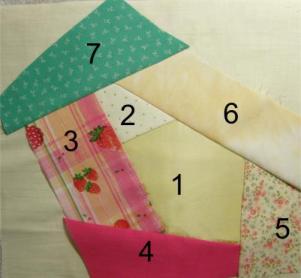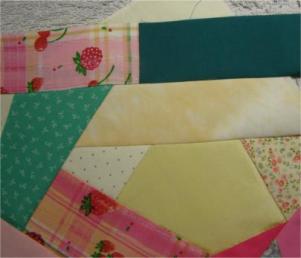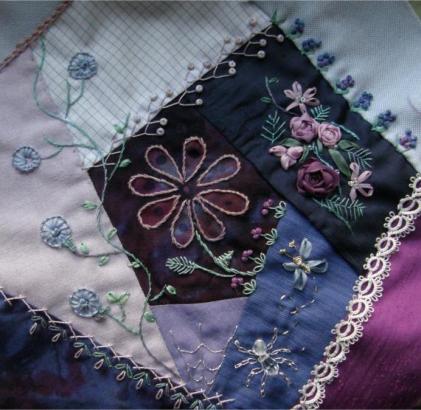- Home
- Crazy Quilting
- Crazy Quilt Block
Piecing a crazy quilt block
using the stitch and flip technique
Are you ready to grab your fabric scraps and create a crazy quilt block unlike any other?
In this tutorial, I'll guide you through making a crazy quilt block. You'll add fabric patches step by step, creating a colorful and textured design.
But this isn't any ordinary quilting technique! Think outside the box and let your imagination run wild. This is your chance to break free from tradition and create something truly one-of-a-kind.
And if you love history, you'll love learning about the Victorian crazy quilts that inspired this technique. But let's not get too caught up in the past—it's time to get stitching!
You might like the calm rhythm of hand-stitching or the speed and precision of a sewing machine. Making a crazy quilt block by hand can be very satisfying so that is the method I am using for this block.
What sparks your creativity?
For me, it's often a chance discovery, like the day I stumbled upon a bundle of fabric scraps in a local craft shop.
In the bundle, I found a lovely printed cotton. It featured juicy strawberries, plump raspberries, and sweet cherries. There was also a bold pink and a creamy white fabric dotted with gold.
I wanted to make a summery crazy quilt block. So, I scoured my scrap bag for matching and contrasting pieces to add to these finds.
I chose my fabrics, laundered and ironed them, and began work.
NOTE: While it's tempting to use any fabric scraps, be mindful of the fabric's weight and texture. Combining thick and thin fabrics might lead to uneven seams or difficulty with stitching, so try to stick with materials that work well together.
Are you ready to join me?

Cutting the first fabric patch (1)

First, cut a square of muslin or calico for the backing. It should be 1 inch (2.5 cm) larger than your desired block size.
I used an irregularly shaped piece of yellow taffeta from my daughter's bridesmaid dress, to make my first patch.
I laid the taffeta on the background square, slightly off centre.
NOTE: If you’re using a delicate or translucent fabric like I did with the taffeta, you may want to use it early in the process to avoid seams showing through.
Cutting the second piece of fabric (2)
I cut a rectangle of gold-spotted cream fabric, allowing a quarter-inch seam allowance. Then laid it on top of one of the edges of the first patch, right sides down. With it pinned in place, I stitched the pieces together with back stitch. You could use your sewing machine.

Pressing the seam and trimming
I finger pressed the seam and trimmed off the edge. Then, I unfolded the fabric and pressed it flat.
I like to keep a folded terry towel on my worktop so that I can press as I go along.
Next, I turned the foundation square one-quarter turn to the right.
Adding a new piece of fabric (3)

I chose the strawberry fabric as the next to include in my crazy quilt block. The pattern had the benefit of giving me a nice straight line to stitch my seam along.
This patch overlays the edges of both existing patches. I stitched and pressed the seam as before.

I pressed the seam and trimmed off the extra fabric. Then, I turned the growing crazy quilt block ninety degrees.
Adding the next patch (4)

I use tailor's chalk, or a disappearing ink pen, to mark the seam allowance on darker, plain fabrics if needed.
This next patch sat alongside the original central patch. I continued the seam until I had joined it along the entire length of the first and the existing patches.
Don't worry about that little section of strawberry fabric sticking out. I cut that off afterward.

After pressing the seam, I cut the pink rectangle at an angle. I did this to add variety to the shapes in my finished project. I left the trimmed section beside the patch so that you could see what I removed.
Continue to add further patches (5)

I made this next patch from a nightdress my daughter used to wear when she was a toddler.
This rectangle lay along the fourth edge of the yellow patch. It lay on top of the pink patch, fitting along the edges of both.

Adding a longer strip of fabric (6)
With this patch, I moved on to longer strips. This one fits along the edges of the central yellow patch, the spotty piece, and also along the one I added above.
I picked a piece of fabric from an old blouse that I tie-dyed back in the 1970's for this patch. I positioned it so that the creamy coloured area met the last patch's print and the yellowy/orange part met the cream spots.
This patch completed my first "journey" around the crazy quilt block.
I still turned the block a quarter turn after attaching each strip.
In the photo, you can see that the "nightie" fabric took me to the edge of the foundation square on that side of the yellow shape. This won't always happen. Normally, you would keep adding patches all around in a second journey.
For this block, I only needed to add shapes to the existing patches on four sides.

Continue to add another "round" of patches (7)
In this photo, I have numbered the patches in the order that I attached them. As you can see, I stitched the green patch (from my daughter's old skirt) to patches 2, 3, and 6.
I shaped this patch to an angle after stitching and pressing.

Adding longer pieced strips (8)
The next patch will lie alongside patches 3, 4 and 7 and so will be longer. To avoid my crazy quilt block ending up looking stripy, I seamed two fabrics together for this length.

I was careful when I attached this strip to the block. I made sure to avoid matching its seam with any others on the block.
Piecing on the diagonal (9)

Again, for this strip I pre-seamed two fabrics together; this time on the diagonal.
I did not trim the patches to shape first. Instead, I laid the new strip in place along patches 4, 5, and 8. I stitched it and then trimmed the excess from the previous patches. I wanted to create a triangle from the existing dark pink patch.

As you can see in the photo, I put the printed fabric in this strip next to the solids in the existing crazy quilt block.
NOTE: When piecing strips together diagonally, be careful to align the seams to avoid creating unintended bumps in your block. If you find your seams are not lining up, don't be afraid to unpick and try again—it's worth getting the alignment right for a smooth final block.
Adding one last long pieced strip (10)

For the last strip, I seamed the dark green and strawberry fabrics together. Then, I stitched them to patches 6 and 7.
The corners were all that remained.
Completing the corners of the crazy quilt block

When adding the corner pieces, I tried to ensure that the patches were different shapes and sizes. I balanced the existing dark pink patch with a second piece of that fabric in the bottom right corner. I used the light pink and cream spotted fabrics for the remaining corners. I also used the "nightie" fabrics again.
The last job was to trim the overhanging patch edges. They should be even with the foundation square. Now, the block is ready for the decorative stitches.
NOTE: After trimming, double-check the block for any areas where fabric might not fully cover the foundation. It's easy to miss a small section near the edges, but this can be fixed by adding a small patch before starting on embellishments.
I created this quilt block using the stitch-and-flip technique of crazy patchwork.
I hope the step-by-step photos and instructions have helped you. They show that piecing your blocks is simple and lots of fun. Now its your turn.
When your block is ready, head over to the crazy quilt embroidery and embellishment page.
If you get stuck you will find more crazy quilting ideas here.
What did you think of this page?
Did it give you all you needed or did anything else spring to mind? If there was something missing give me a shout – or let me know if this page proved helpful (do let me know which page you are commenting on). Would you like a direct reply? Just pop your email address below, and I'll be in touch.




